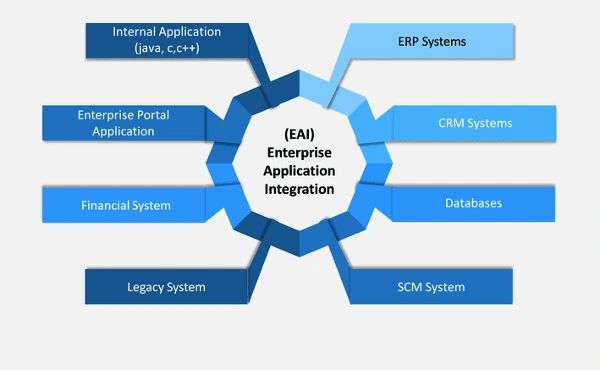To remain competitive in the fast-paced business world of today, efficiency is crucial. Businesses get more difficult as they expand in size. It can be quite taxing to handle enormous volumes of data, different software systems, and maintain excellent departmental communication. This is where enterprise integration apps come into play, providing a way to optimize productivity and simplify processes.
Applications for enterprise integration have completely changed how companies handle their internal operations. These solutions allow for smooth data interchange and process automation by bridging the gap between different software applications. Whether you're utilizing a software development service or managing internal systems, these tools ensure seamless integration. Regardless of your industry—manufacturing, retail, banking, or any other—an enterprise integration program can greatly improve the operation of your company.
What is an Enterprise Integration Application?
A software program known as an enterprise integration application links various systems inside a company, facilitating easy data sharing and communication between them. It ensures that all departments have access to the same current data by doing away with the necessity for repetitive chores or manual data entry. For companies that utilize several software systems for distinct tasks, like accounting, human resources, and customer relationship management (CRM), this kind of connectivity is essential.
A comprehensive perspective of business activities is provided by an enterprise integration application, which combines traditional software, which may only be used for particular tasks, into a single system. This integration minimizes errors that may arise from manual data transfer in addition to saving time.
The Significance of Enterprise Integration for Efficiency
The foundation of a successful business is efficiency. A corporation can compete in the market and provide better customer service if it can run its operations more efficiently. Enterprise integration applications can help firms become much more efficient in a number of ways.
Streamlined Communication:
The capacity to link different systems across departments is one of the main advantages of business integration. With real-time access to the same data, there are fewer delays and misunderstandings in sales, marketing, and logistics.
Centralized Data Management:
All company data is consolidated into a single system using an enterprise integration tool. This guarantees correctness on all platforms and removes the need to extract data from various sources. A single source of truth enables companies to make faster, data-driven decisions.
Workflows that are Automated:
An essential component of every effective corporate integration program is automation. Data entry, report creation, and order processing are examples of repetitive processes that can be automated to free up staff time for more strategic work. This increases output while guaranteeing error-free completion of regular activities.
Scalability:
The operational demands of businesses expand along with their size. Scalability refers to an enterprise integration application's ability to handle an increase in data volume and transaction volume as your firm grows. It is therefore the perfect option for businesses trying to future-proof their operations.
Applications of EAI for Increasing Business Efficiency

apps for enterprise integration are often known as EAI (Enterprise Application Integration) apps. The smooth integration of various systems inside an organization is made possible by an EAI application. Businesses may make sure that all of their software platforms—from CRM to ERP systems—integrate well with one another by using an EAI solution.
An EAI application is wonderful because it functions as a middleware, allowing many programs to be connected without requiring significant alterations to the current systems. This guarantees that companies may benefit from integration while keeping their favorite tools. Furthermore, the flexibility offered by EAI applications enables companies to modify their operations to accommodate new software or industry standards without affecting their current workflows.
Principal Advantages of Applications for Enterprise Integration
Better Decision-Making:
Businesses may make decisions more quickly and intelligently when they have access to real-time data through a centralized system. Managers don't have to extract information from many platforms in order to gain insights into sales trends, consumer behavior, and performance metrics.
Improved Cooperation:
When every department uses the same data, cooperation increases. Teams may work together on projects, exchange information, and monitor project status without the typical obstacles brought on by isolated platforms.
Cost Savings:
Enterprise integration applications help firms save time and money by automating repetitive operations and lowering errors. Workers are free to concentrate on tasks that provide value, and the chance of expensive errors is reduced because fewer manual interventions are required.
Improved Customer Experience:
Better customer service is a direct result of more efficient operations. Customers will gain from a well running firm, whether it's through quicker order processing or precise inventory management. Enterprise integration applications enable businesses to optimize customer-facing procedures for maximum efficiency.
Selecting the Appropriate Application for Enterprise Integration
Applications for enterprise integration are not all made equal. Take into consideration the following elements while selecting the best solution for your company:
Compatibility:
Make sure the business integration application is compatible with the software systems you currently have in place. The program must to be able to easily interact with the tools you already have without needing any major adjustments.
Scalability:
Your company's integration requirements may change as it expands. Select a system that is expandable so that it can grow with your company without requiring regular upgrades or replacements.
Usability:
An business integration application should make tasks easier to perform rather than harder. Make sure the software is easy to use and doesn't require your staff to undergo a lot of training.
Security:
In any organization, data security is crucial. To safeguard confidential company data, select an enterprise integration program with strong security features like encryption and access controls.
Overcoming Typical Integration Obstacles
Although corporate integration apps have many advantages, there could be some difficulties in the implementation process for enterprises. These difficulties may manifest as integration difficulties, data migration problems, or reluctance to change. However, these difficulties are surmountable with the appropriate strategy:
Involve Stakeholders:
Ensuring that everyone is aware of the advantages of the integration requires involving important stakeholders early in the process. This can guarantee a more seamless deployment and lessen opposition to change.
Make a Plan for Data Migration:
It can be difficult to transfer data from several systems into a single integrated platform. To guarantee a seamless move and reduce operational disruptions, collaborate with your IT staff.
Give Training:
In order for staff members to utilize the new system efficiently, they may require training. Giving them enough assistance and training will enable them to swiftly adjust and take full use of the system's advantages.
Conclusion
Efficiency is essential for success in a company environment that is changing quickly. Businesses can increase cooperation, cut expenses, and optimize processes by putting in place an enterprise integration application. The advantages are obvious, ranging from real-time data access to automated workflows. Enterprise integration apps will become more and more important as companies continue to embrace digital transformation in order to develop and remain competitive. If you want to learn more about Enterprise Resource Planning, check out our blog ERP Databases Explained: Top Enterprise Resource Planning Examples

